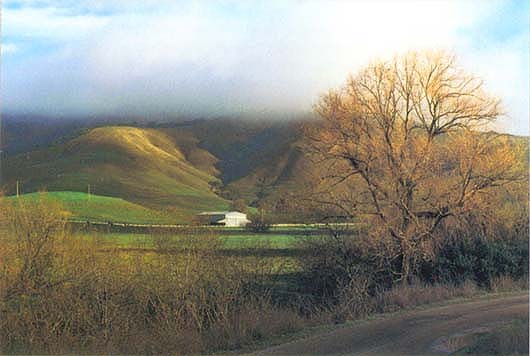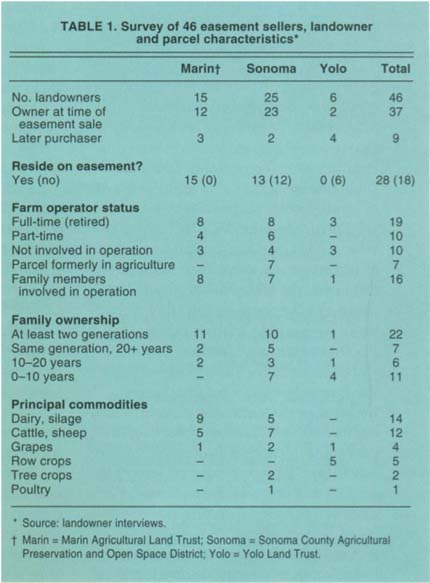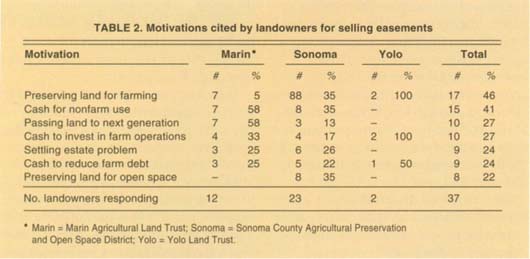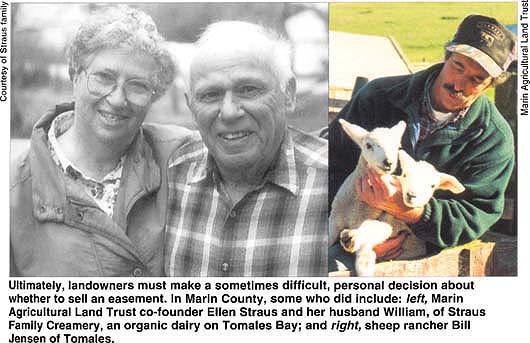All Issues
Landowners, while pleased with agricultural easements, suggest improvements
Publication Information
California Agriculture 56(1):21-25. https://doi.org/10.3733/ca.v056n01p21
Published January 01, 2002
PDF | Citation | Permissions
Abstract
We extensively interviewed 46 landowners in two northern Bay Area counties and nearby Yolo County to assess their satisfaction with agricultural conservation easements. The landowners in most cases were enthusiastic sellers of the easements; their motivations included cash, keeping land in the family and conservation. They reported generally satisfactory experiences with the easement programs. To a lesser degree they expressed concerns about certain aspects of the easement process, especially negotiations and monitoring, and suggested ways that easement programs can improve their relationships with landowners.
Full text
For a landowner, the decision to sell or donate an agricultural conservation easement is a momentous one that is not made lightly or quickly. Negotiated voluntarily with a nonprofit or public land-trust agency, conservation easements restrict the use of a particular parcel; the landowner can continue farming after the easement is purchased, but the land can never be subdivided or developed. Land in easements can be bought or sold, but the restrictions remain in perpetuity. The decision to sell, then, depends on the landowner's willingness to forego the profitable option of selling the land for urban development in return for more modest economic gains and other benefits. While cash or tax advantages provide immediate benefits to the present landowner, future generations and owners carry the costs in terms of restrictions and limited opportunities.
In a survey, the main reasons landowners cited for selling easements were cash, maintaining family ownership and conservation. In Marin County, Marin Agricultural Land Trust's purchase of a 400-acre easement allowed the lelmorini family to buy this dairy, which they had leased for 6 years.
Based on extensive interviews with 46 owners of easement-restricted farms in three counties (Rilla and Sokolow 2000), we have examined landowner motivations for selling easements and their experiences with local programs that acquired the easements (Sherman et al. 1998; Maynard et al. 1998; Elconin and Luzadis 1997). The landowners in most cases were enthusiastic sellers of the easements. Their main motivations were cash, family ownership and conservation, and they reported generally satisfactory experiences with the easement programs. To a lesser degree they expressed concerns about certain aspects of the process, especially negotiations and monitoring, and suggested ways that easement programs can improve their relationships with landowners.
Most of the landowners interviewed are located in two North Bay counties, the region that contains most of California's farmland easement acres and easement programs. Given the unique conservation, landscape and agricultural characteristics of this region, it's not yet clear what the prospects are for easement programs statewide and in the agriculturally rich Central Valley, where they are much less well-established (see p. 22 ).
Landowners surveyed
The landowners who participated in this study are involved in three of the most active agricultural easement programs in California. The programs are countywide in scope. The Marin Agricultural Land Trust (formed in 1980) and Yolo Land Trust (formed in 1988) are private, nonprofit organizations, chartered under state law to engage in conservation activities. The Sonoma County Agricultural Preservation and Open Space District is a public district formed by a county ballot initiative in 1990 and operated by a county government agency. Their easements total more than 53,000 acres, nearly half of all agricultural easement acres in California. Both the Marin and Sonoma county programs are among the six largest local agricultural easement programs in the nation (Bowers 2001).
We surveyed 46 landowners in the Sonoma, Marin and Yolo county programs by phone and in person from February to August 1999, using a standardized interview guide. The interviews ranged from 15 minutes to 1 hour and were taped and later transcribed for analysis. Interview topics included questions about motivations, negotiations with land trusts, perceptions about program success and other experiences related to their conservation easement. The 46 landowners represented 44% of the total of 105 landowners participating in the three programs. Thirty-seven had sold such easements in recent years; the other nine owners had recently purchased parcels with easements already in place (table 1). Their parcels represented a majority (55%) of the total 53,000 easement acres held by the three programs at that time. The average parcel size was 530 acres.
Motivations for selling rights
The survey revealed some common threads about why landowners made the decision to sell development rights (table 2). While the 37 original sellers of easements gave seven discrete reasons, there were obvious similarities and overlaps. Combined, three major motivations surfaced: to preserve land for farming and/or open space (mentioned by 25 respondents); to provide cash for savings and retirement, for farm improvements or to reduce debt (34 mentions); and to serve family needs such as estate settlements and generational transfers (19 mentions). Several landowners received tax benefits by donating a partial portion of their easement.
Most respondents cited a combination of at least two of these motivations. Certainly cash was a powerful incentive, since giving up development rights typically meant that the landowners received at least several hundred thousand dollars per transaction and more than a million dollars in a few cases. But in many cases the cash was valued mainly as a vehicle for accomplishing one or another of the other objectives.
Personal attachment to a parcel was another widely held sentiment, with many respondents noting a long history of family ownership and the importance of their farms as home sites. Several landowners spoke about the need to facilitate an intergenerational transfer.
The immediate goal for some was to overcome a fragmented family ownership that made continued farming uncertain. The cash from the easement
sale could help the younger family members purchase the parcel from the older generation or prepare for the transition by paying down existing farm debt or improving the farm operation. In one situation, the farm operator used the proceeds from the easement sale to secure full control of the land by buying out the ownership shares of his siblings.Surprisingly, the permanence of a deed restriction — the issue of keeping the land in agriculture in perpetuity, essentially forever — did not discourage landowners from selling easements. However, this sample includes only participating landowners and not those who might have chosen not to sell because of this restriction. Only five respondents expressed some discomfort with the permanent nature of their easement. In fact, for the majority of landowners, perpetuity was considered an advantage because their goal was to pass the land on, undeveloped, to future generations. One respondent did argue for less-than-permanent easements because he felt they were more compatible with the economic fluctuations in agriculture.
For most of the nine landowners in the three counties who purchased their properties after the development rights had been removed, having an easement in place was considered an advantage. The principal reason, they said, is that it made the purchase more affordable. By eliminating the possibility of development, an easement in effect reduces the market value from a speculative to a farm production level.
Program shortfalls
When asked about the effectiveness and impact of the program's public goals such as slowing urbanization and preserving farmland, the great majority (83%) of landowners stated that the programs were successful. However, they expressed some common reservations and concerns about the easement programs, including that they:
-
Pay too much for easements on particular parcels.
-
Acquire easements on parcels that would not be subject to development in any case.
-
Do little to stem the continuing loss of farmland or maintain the long-term viability of local agriculture, due to larger economic forces.
-
Are too bureaucratic, have too large a staff or conduct affairs in a political manner.
-
Have insufficient funds to continue easement program purchases.
-
Are unsympathetic to farmers.
Landowner-program relationship
At the heart of the easement process is the relationship between the landowner and the land trust or other conservation organization that acquires the easement, whether through purchase or donation. It begins with a conversation about the possibility of a landowner entering into an easement transaction, and continues through formal negotiations over price and other terms. After acquisition, the agency periodically monitors compliance with the easement terms. Land-owners may also be involved in the organization's other activities.
We asked the 37 landowners in three counties who had sold easements to describe their easement-related experiences with the land trust or open space district. While landowners were generally positive about their experiences, they also had specific recommendations for how the three organizations could improve their relationships with landowners. The majority of the comments centered on negotiating easement terms and the agency's ongoing monitoring of their properties.
Negotiations
Discussions between the landowner and the conservation organization usually focus on two areas: the price, and changes in the use and character of the covered parcel that the easement will allow. One area of landowner concern was the time it took in some cases to negotiate and complete a transaction. Various factors can complicate and lengthen the process: disagreements over price that require more than one appraisal, landowner consultations with attorneys or consultants, or delays until the land trust receives the funds to close the deal.
One landowner in Yolo County, who purchased a parcel after the easement was in place, had no idea that he wouldn't be able to build a home because of specific restrictions named in the deed. Landowners suggested that programs should seek ways to clarify and expedite easement negotiations and terms. They felt that if programs provided complete information upfront, and made sure purchasers understood the easement terms including the conditions of monitoring and use restrictions, misunderstandings and negative feelings would be reduced.
The most frequent sticking point seemed to be the construction of additional residences or farm outbuildings. Landowners wanted the flexibility to house family members or farm-workers. Several landowners expressed the opinion, when asked if they would participate again, that they would revise their easement deeds to provide more flexibility for family
Ultimately, landowners must make a sometimes difficult, personal decision about whether to sell an easement. In Marin County, some who did include: left, Marin Agricultural Land Trust co-founder Ellen Straus and her husband William, of Straus Family Creamery, an organic dairy on Tomales Bay; and right, sheep rancher Bill Jensen of Tomales.
Monitoring
Contact between the landowner and the conservation organization does not end at completion of the easement transaction. The easement terms require that the relationship continue indefinitely to ensure that landowners adhere to the restrictions that have been placed on the property. Program staff or volunteers periodically monitor the uses and conditions of the property, typically through annual site checks and other forms of data collection.
Monitoring of easements was controversial among some of those we interviewed. Of the 33 respondents who commented on the subject, 14 reported negative experiences or perceptions of the process. Landowners do not like intrusions on their property regardless of whether they agreed to them on paper. Landowners suggested that programs monitor easement-restricted parcels as a cooperative rather than adversarial process. They suggested that the personnel responsible should be sensitive to local circumstances, be knowledgeable about local agricultural practices and provide more practical assistance with improving land management practices.
Statewide applications
Easements are unquestionably a flexible tool for advancing the individual, family and business goals of farmland owners, as suggested by the owners who sold easements in three California counties. They liked the economic and conservation benefits of the transactions, and were largely positive about the negotiations and other experiences with conservation agencies. Nonetheless, while the easement programs seemed to work for farmers in the northern Bay Area counties and Yolo County, it's not clear that they will appeal to landowners in other parts of the state and, in particular, the agriculturally rich Central Valley. This region differs from the three counties we surveyed in having a greater diversity of agricultural crops, no coastal zones to justify the protection of farmland as open space, less apparent community support for land preservation programs and perhaps a more conservative agricultural community.
What landowners say about their conservation easements
“It allowed us to buy the dairy and keep the land in agricultural production. It would have been very difficult otherwise. Now 1 plan to keep this in agricultural production and hand it down to future generations.”
— Nicasio farmers who used easement funds to purchase leased dairy
“The price of preservation is high for those who retain ownership of the land. A big problem we face is inheritance tax. The land has escalated in value way beyond what we're able to pay. I'm 60 years old and in a position to be both inheriting it and passing it on. I would have had to sell the farm, and that's the last thing I want to do.”
— Marin landowner
“We didn't have any debt on the property. We looked at the easement in terms of the money it would bring. I haven't done anything more with it than draw interest. It's a long-term investment gain, or maybe we can use it for houses (on the land) for the children.”
— Sonoma landowner
“More farm properties would get carved up upon death of the owners because of estate issues. The long-term effect of this program is to keep properties intact.”
— Sonoma landowner
“The easement program gets around the zoning, which can be changed by the board of supervisors. Nothing is forever with zoning — it can be changed on a whim. The easement is a forever thing.”
— Yolo landowner








